Intercomparison of Indoor and Outdoor Pollen Concentrations in Rural and Suburban Research Workplaces
Abstract
:1. Introduction
2. Materials and Methods
2.1. Study Sites and Vegetation
2.2. Aerobiological Monitoring
2.3. Meteorological Monitoring
2.4. Data Analysis
- outdoor and indoor pollen characterization in WDs and NWDs, WHs and NWHs in the two sites;
- the peak analysis, where the maximum of the outdoor pollen concentration for each day of measure is selected and related to the meteorological conditions;
- finally, the indoor and outdoor Ratios (I/O) are calculated and compared for the two sites.
3. Results and Discussion
3.1. Average Pollen Values for TV and MPC
3.2. Land Use Characterization of TV and MPC
3.3. Study of Meteorological Variables and Pollen Concentrations
3.4. Analysis of Typical Days NWDS and WDS for Indoor and Outdoor Pollen Concentrations
3.5. Peaks Analysis: Comparison between Outdoor Pollen in the Two Monitoring Sites
3.5.1. Two Hour Resolution Analysis
3.5.2. Six Hours Resolution Analysis
3.6. Evaluation of I/O Ratios for TV and MPC
4. Conclusions
Author Contributions
Funding
Institutional Review Board Statement
Informed Consent Statement
Conflicts of Interest
References
- EAACI. White Paper on Research, Innovation and Quality Care; Agache, I., Akdis, C.A., Chivato, T., Hellings, P., Hoffman-Sommergruber, K., Jutel, M., Lauerma, A., Papadopoulos, N., Schmid-Grendelmeier, P., Schmidt-Weber, C., Eds.; European Academy of Allergy and Clinical Immunology (EAACI): Zurich, Switzerland, 2018. [Google Scholar]
- EAACI. Global Atlas of Asthma; Akdis, C.A., Agache, I., Eds.; European Academy of Allergy and Clinical Immunology (EAACI): Zurich, Switzerland, 2013. [Google Scholar]
- World Allergy Organization (WAO). White Book on Allergy: Update 2013; Pawankar, R., Canonica, G.W., Holgate, S.T., Lockey, R.F., Blaiss, M.S., Eds.; World Allergy Organization (WAO): Milwaukee, WI, USA, 2013. [Google Scholar]
- EAACI. Global Atlas of Allergy; Akdis, C.A., Agache, I., Eds.; European Academy of Allergy and Clinical Immunology (EAACI): Zurich, Switzerland, 2014. [Google Scholar]
- Xie, W.; Li, Y.; Bai, W.; Hou, J.; Ma, T.; Zeng, X.; Zhang, L.; An, T. The source and transport of bioaerosols in the air: A review. Front. Environ. Sci. Eng. 2021, 15, 44. [Google Scholar] [CrossRef]
- Joubert, A.I.; Geppert, M.; Johnson, L.; Mills-Goodlet, R.; Michelini, S.; Korotchenko, E.; Duschl, A.; Weiss, R.; Horejs-Höck, J.; Himly, M. Mechanisms of particles in sensitization, effector function and therapy of allergic disease. Front. Immunol. 2020, 11, 1334. [Google Scholar] [CrossRef]
- Idrose, N.S.; Walters, E.H.; Zhang, J.; Vicendese, D.; Newbigin, E.J.; Douglass, J.A.; Erbas, B.; Lowe, A.J.; Perret, J.L.; Lodge, C.J.; et al. Outdoor pollen-related changes in lung function and markers of airway inflammation: A systematic review and meta-analysis. Clin. Exp. Allergy 2021, 51, 636–653. [Google Scholar] [CrossRef]
- Hoogeveen, M.J.; van Gorp, E.C.M.; Hoogeveen, E.K. Can pollen explain the seasonality of flu-like illnesses in the Netherlands? Sci. Total Environ. 2021, 755, 143182. [Google Scholar] [CrossRef]
- Hoogeveen, M.J. Pollen likely seasonal factor in inhibiting flu-like epidemics. A Dutch study into the inverse relation between pollen counts, hay fever and flu-like incidence 2016–2019. Sci. Total Environ. 2020, 727, 138543. [Google Scholar] [CrossRef] [PubMed]
- Damialis, A.; Gilles, S.; Sofiev, M.; Sofieva, V.; Kolek, F.; Bayr, D.; Plaza, M.P.; Leier-Wirtz, V.; Kaschuba, S.; Ziska, L.H.; et al. Higher airborne pollen concentrations correlated with increased SARS-CoV-2 infection rates, as evidenced from 31 countries across the globe. Proc. Natl. Acad. Sci. USA 2021, 18, e2019034118. [Google Scholar] [CrossRef]
- Awaya, A.; Kuroiwa, Y. The relationship between annual airborne pollen levels and occurrence of all cancers, and lung, stomach, colorectal, pancreatic and breast cancers: A retrospective study from the National Registry Database of cancer incidence in Japan, 1975–2015. Int. J. Environ. Res. Public Health 2020, 17, 3950. [Google Scholar] [CrossRef]
- Rowney, F.M.; Brennan, G.L.; Skjøth, C.A.; Griffith, G.W.; McInnes, R.N.; Clewlow, Y.; Adams-Groom, B.; Barber, A.; de Vere, N.; Economou, T.; et al. Environmental DNA reveals links between abundance and composition of airborne grass pollen and respiratory health. Curr. Biol. 2021, 31, 1995–2003.e4. [Google Scholar] [CrossRef] [PubMed]
- Ortega-Rosas, C.I.; Meza-Figueroa, D.; Vidal-Solano, J.R.; González-Grijalva, B.; Schiavo, B. Association of airborne particulate matter with pollen, fungal spores, and allergic symptoms in an arid urbanized area. Environ. Geochem. Health 2021, 43, 1761–1782. [Google Scholar] [CrossRef] [PubMed]
- Sedghy, F.; Varasteh, A.R.; Saukian, M.; Moghadam, M. Interaction between air pollutants and pollen grains: The role on the rising trend in allergy. Rep. Biochem. Mol. Biol. 2018, 6, 219–224. [Google Scholar]
- Wimalasena, N.N.; Chang-Richards, A.; Wang, K.I.; Dirks, K.N. Housing risk factors associated with respiratory disease: A systematic review. Int. J. Environ. Res. Public Health 2021, 18, 2815. [Google Scholar] [CrossRef]
- Chimed-Ochir, O.; Ikaga, T.; Ando, S.; Ishimaru, T.; Kubo, T.; Murakami, S.; Fujino, Y. Effect of housing condition on quality of life. Indoor Air 2021, 31, 1029–1037. [Google Scholar] [CrossRef]
- Meima, M.; Kuijpers, E.; van den Berg, C.; Kruizinga, A.; van Kesteren, N.; Spaan, S. Biological Agents and Prevention of Work-Related Diseases: A Review; European Agency for Safety and Health at Work (EU-OSHA): Bilbao, Spain, 2020. [Google Scholar]
- Jumat, M.I.; Hayati, F.; Syed Abdul Rahim, S.S.; Saupin, S.; Awang Lukman, K.; Jeffree, M.S.; Lasimbang, H.B.; Kadir, F. Occupational lung disease: A narrative review of lung conditions from the workplace. Ann. Med. Surg. 2021, 64, 102245. [Google Scholar] [CrossRef] [PubMed]
- D’Ovidio, M.C.; Di Renzi, S.; Capone, P.; Pelliccioni, A. Pollen and fungal spores evaluation in relation to occupants and microclimate in indoor workplaces. Sustainability 2021, 13, 3154. [Google Scholar] [CrossRef]
- Pelliccioni, A.; Gherardi, M. Development and validation of an intra-calibration procedure for MiniDISCs measuring ultrafine particles in multi-spatial indoor environments. Atmos. Environ. 2021, 246, 118154. [Google Scholar] [CrossRef]
- Yang, S.; Bekö, G.; Wargocki, P.; Williams, J.; Licina, D. Human emissions of size-resolved fluorescent aerosol particles: Influence of personal and environmental factors. Environ. Sci. Technol. 2021, 55, 509–518. [Google Scholar] [CrossRef] [PubMed]
- Anenberg, S.C.; Haines, S.; Wang, E.; Nassikas, N.; Kinney, P.L. Synergistic health effects of air pollution, temperature, and pollen exposure: A systematic review of epidemiological evidence. Environ. Health 2020, 19, 130. [Google Scholar] [CrossRef] [PubMed]
- Grewling, Ł.; Bogawski, P.; Kostecki, Ł.; Nowak, M.; Szymańska, A.; Frątczak, A. Atmospheric exposure to the major Artemisia pollen allergen (Art v 1): Seasonality, impact of weather, and clinical implications. Sci. Total Environ. 2020, 713, 136611. [Google Scholar] [CrossRef] [PubMed]
- Damialis, A.; Gioulekas, D.; Lazopoulou, C.; Balafoutis, C.; Vokou, D. Transport of airborne pollen into the city of Thessaloniki: The effects of wind direction, speed and persistence. Int. J. Biometeorol. 2005, 49, 139–145. [Google Scholar] [CrossRef]
- Hernández-Ceballos, M.A.; García-Mozo, H.; Galán, C. Cluster analysis of intradiurnal holm oak pollen cycles at peri-urban and rural sampling sites in southwestern Spain. Int. J. Biometeorol. 2015, 59, 971–982. [Google Scholar] [CrossRef] [PubMed]
- Ríos, B.; Torres-Jardón, R.; Ramírez-Arriaga, E.; Martínez-Bernal, A.; Rosas, I. Diurnal variations of airborne pollen concentration and the effect of ambient temperature in three sites of Mexico City. Int. J. Biometeorol. 2016, 60, 771–787. [Google Scholar] [CrossRef]
- Puc, M. Influence of meteorological parameters and air pollution on hourly fluctuation of birch (Betula L.) and ash (Fraxinus L.) airborne pollen. Ann. Agric. Environ. Med. 2012, 19, 660–665. [Google Scholar]
- Plaza, M.P.; Alcázar, P.; Oteros, J.; Galán, C. Atmospheric pollutants and their association with olive and grass aeroallergen concentrations in Córdoba (Spain). Environ. Sci. Pollut. Res. 2020, 27, 45447–45459. [Google Scholar] [CrossRef] [PubMed]
- Sénéchal, H.; Visez, N.; Charpin, D.; Shahali, Y.; Peltre, G.; Biolley, J.P.; Lhuissier, F.; Couderc, R.; Yamada, O.; Malrat-Domenge, A.; et al. A review of the effects of major atmospheric pollutants on pollen grains, pollen content, and allergenicity. Sci. World J. 2015, 2015, 940243. [Google Scholar] [CrossRef] [PubMed] [Green Version]
- Lam, H.C.Y.; Jarvis, D.; Fuertes, E. Interactive effects of allergens and air pollution on respiratory health: A systematic review. Sci. Total Environ. 2021, 757, 143924. [Google Scholar] [CrossRef] [PubMed]
- Phosri, A.; Ueda, K.; Tasmin, S.; Kishikawa, R.; Hayashi, M.; Hara, K.; Uehara, Y.; Phung, V.L.H.; Yasukouchi, S.; Konishi, S.; et al. Interactive effects of specific fine particulate matter compositions and airborne pollen on frequency of clinic visits for pollinosis in Fukuoka, Japan. Environ. Res. 2017, 156, 411–419. [Google Scholar] [CrossRef]
- Ziemianin, M.; Waga, J.; Czarnobilska, E.; Myszkowska, D. Changes in qualitative and quantitative traits of birch (Betula pendula) pollen allergenic proteins in relation to the pollution contamination. Environ. Sci. Pollut. Res. 2021, 28, 39952–39965. [Google Scholar] [CrossRef]
- Zhou, S.; Wang, X.; Lu, S.; Yao, C.; Zhang, L.; Rao, L.; Liu, X.; Zhang, W.; Li, S.; Wang, W.; et al. Characterization of allergenicity of Platanus pollen allergen a 3 (Pla a 3) after exposure to NO2 and O3. Environ. Pollut. 2021, 278, 116913. [Google Scholar] [CrossRef]
- Cariñanos, P.; Foyo-Moreno, I.; Alados, I.; Guerrero-Rascado, J.L.; Ruiz-Peñuela, S.; Titos, G.; Cazorla, A.; Alados-Arboledas, L.; Díaz de la Guardia, C. Bioaerosols in urban environments: Trends and interactions with pollutants and meteorological variables based on quasi-climatological series. J. Environ. Manag. 2021, 282, 111963. [Google Scholar] [CrossRef]
- Hugg, T.T.; Hjort, J.; Antikainen, H.; Rusanen, J.; Tuokila, M.; Korkonen, S.; Weckstrom, J.; Jaakkola, M.S.; Jaakkola, J.J.K. Urbanity as a determinant of exposure to grass pollen in Helsinki Metropolitan area, Finland. PLoS ONE 2017, 12, e0186348. [Google Scholar] [CrossRef]
- Bosch-Cano, F.; Bernard, N.; Sudre, B.; Gillet, F.; Thibaudon, M.; Richard, H.; Badot, P.M.; Ruffaldi, P. Human exposure to allergenic pollens: A comparison between urban and rural areas. Environ. Res. 2011, 111, 619–625. [Google Scholar] [CrossRef] [Green Version]
- Vrinceanu, D.; Berghi, O.N.; Cergan, R.; Dumitru, M.; Ciuluvica, R.C.; Giurcaneanu, C.; Neagos, A. Urban allergy review: Allergic rhinitis and asthma with plane tree sensitization (Review). Exp. Ther. Med. 2021, 21, 275. [Google Scholar] [CrossRef]
- Maya-Manzano, J.M.; Sadyś, M.; Tormo-Molina, R.; Fernández-Rodríguez, S.; Oteros, J.; Silva-Palacios, I.; Gonzalo-Garijo, A. Relationships between airborne pollen grains, wind direction and land cover using GIS and circular statistics. Sci. Total Environ. 2017, 584–585, 603–613. [Google Scholar] [CrossRef]
- Glick, S.; Gehrig, R.; Eeftens, M. Multi-decade changes in pollen season onset, duration, and intensity: A concern for public health? Sci. Total Environ. 2021, 781, 146382. [Google Scholar] [CrossRef] [PubMed]
- Uguz, U.; Guvensen, A.; Tort, N.S. Annual and intradiurnal variation of dominant airborne pollen and the effects of meteorological factors in Cesme (Izmir, Turkey). Environ. Monit. Assess. 2017, 189, 530. [Google Scholar] [CrossRef] [PubMed]
- Ziska, L.H.; Makra, L.; Harry, S.K.; Bruffaerts, N.; Hendrickx, M.; Coates, F.; Saarto, A.; Thibaudon, M.; Oliver, G.; Damialis, A.; et al. Temperature-related changes in airborne allergenic pollen abundance and seasonality across the northern hemisphere: A retrospective data analysis. Lancet Planet Health 2019, 3, e124–e131. [Google Scholar] [CrossRef] [Green Version]
- Lipiec, A.; Rapiejko, P.; Furmańczyk, K.; Jurkiewicz, D. The dynamics of pollen seasons of the most allergenic plants-15-year observations in Warsaw. Otolaryngol. Pol. 2018, 72, 43–52. [Google Scholar] [CrossRef]
- Zhang, Y.; Bielory, L.; Mi, Z.; Cai, T.; Robock, A.; Georgopoulos, P. Allergenic pollen season variations in the past two decades under changing climate in the United States. Glob. Chang. Biol. 2015, 21, 1581–1589. [Google Scholar] [CrossRef] [PubMed] [Green Version]
- De Roos, A.J.; Kenyon, C.C.; Zhao, Y.; Moore, K.; Melly, S.; Hubbard, R.A.; Henrickson, S.E.; Forrest, C.B.; Diez Roux, A.V.; Maltenfort, M.; et al. Ambient daily pollen levels in association with asthma exacerbation among children in Philadelphia, Pennsylvania. Environ. Int. 2020, 145, 106138. [Google Scholar] [CrossRef]
- Ouyang, Y.; Yin, Z.; Li, Y.; Fan, E.; Zhang, L. Associations among air pollutants, grass pollens, and daily number of grass pollen allergen-positive patients: A longitudinal study from 2012 to 2016. Int. Forum Allergy Rhinol. 2019, 9, 1297–1303. [Google Scholar] [CrossRef] [PubMed]
- Zewdie, G.K.; Lary, D.J.; Liu, X.; Wu, D.; Levetin, E. Estimating the daily pollen concentration in the atmosphere using machine learning and NEXRAD weather radar data. Environ. Monit. Assess. 2019, 191, 418. [Google Scholar] [CrossRef] [PubMed]
- Tosunoglu, A.; Bicakci, A. Seasonal and intradiurnal variation of airborne pollen concentrations in Bodrum, SW Turkey. Environ. Monit. Assess. 2015, 187, 167. [Google Scholar] [CrossRef] [PubMed]
- Pérez-Badia, R.; Vaquero, C.; Sardinero, S.; Galán, C.; García-Mozo, H. Intradiurnal variations of allergenic tree pollen in the atmosphere of Toledo (central Spain). Ann. Agric. Environ. Med. 2010, 17, 269–275. [Google Scholar]
- Ribeiro, H.; Oliveira, M.; Abreu, I. Intradiurnal variation of allergenic pollen in the city of Porto (Portugal). Aerobiologia 2008, 24, 173–177. [Google Scholar] [CrossRef]
- Pérez, C.F.; Gardiol, J.M.; Paez, M.M. Comparison of diurnal variation of airborne pollen in Mar del Plata (Argentina). Grana 2003, 42, 161–167. [Google Scholar] [CrossRef] [Green Version]
- Trigo, M.D.M.; Recio, M.; Toro, F.J.; Cabezudo, B. Intradiurnal fluctuations in airborne pollen in Málaga (S. Spain): A quantitative method. Grana 1997, 36, 39–43. [Google Scholar] [CrossRef] [Green Version]
- Galán, C.; Cuevas, J.; Infante, F.; Domínguez, E. Seasonal and diurnal variation of pollen from Gramineae in the atmosphere of Cordoba Spain. Allergol. Immunopathol. 1989, 17, 245–249. [Google Scholar]
- Fernández-Rodríguez, S.; Maya-Manzano, J.M.; Colín, A.M.; Pecero-Casimiro, R.; Buters, J.; Oteros, J. Understanding hourly patterns of Olea pollen concentrations as tool for the environmental impact assessment. Sci. Total Environ. 2020, 736, 139363. [Google Scholar] [CrossRef]
- Munoz Rodriguez, A.F.; Palacios, I.; Molina, R. Influence of meteorological parameters in hourly patterns of grass (Poaceae) pollen concentrations. Ann. Agric. Environ. Med. 2010, 17, 87–100. [Google Scholar] [PubMed]
- Lipiec, A.; Puc, M.; Kruczek, A. Exposure to pollen allergens in allergic rhinitis expressed by diurnal variation of airborne tree pollen in urban and rural area. Otolaryngol. Pol. 2019, 74, 1–6. [Google Scholar] [CrossRef] [PubMed]
- Alcázar, P.; Ørby, P.V.; Oteros, J.; Skjøth, C.; Hertel, O.; Galán, C. Cluster analysis of variations in the diurnal pattern of grass pollen concentrations in Northern Europe (Copenhagen) and Southern Europe (Córdoba). Aerobiologia 2019, 35, 269–281. [Google Scholar] [CrossRef]
- Kasprzyk, I. Comparative study of seasonal and intradiurnal variation of airborne herbaceous pollen in urban and rural areas. Aerobiologia 2006, 22, 185–195. [Google Scholar] [CrossRef]
- Norris-Hill, J. The diurnal variation of Poaceae pollen concentrations in a rural area. Grana 1999, 38, 301–305. [Google Scholar] [CrossRef]
- Bagheri, O.; Moeltner, K.; Yang, W. Respiratory illness, hospital visits, and health costs: Is it air pollution or pollen? Environ. Res. 2020, 187, 109572. [Google Scholar] [CrossRef]
- Crystal-Peters, J.; Crown, W.H.; Goetzel, R.Z.; Schutt, D.C. The cost of productivity losses associated with allergic rhinitis. Am. J. Manag. Care 2000, 6, 373–378. [Google Scholar] [PubMed]
- D’Ovidio, M.C.; Annesi-Maesano, I.; D’Amato, G.; Cecchi, L. Climate change and occupational allergies: An overview on biological pollution, exposure and prevention. Ann. Ist. Super. Sanità 2016, 52, 406–414. [Google Scholar] [CrossRef] [PubMed]
- Lancia, A.; Capone, P.; Vonesch, N.; Pelliccioni, A.; Grandi, C.; Magri, D.; D’Ovidio, M.C. Research progress on aerobiology in the last 30 years: A focus on methodology and occupational health. Sustainability 2021, 13, 4337. [Google Scholar] [CrossRef]
- Damialis, A.; Konstantinou, G.N. Cereal pollen sensitisation in pollen allergic patients: To treat or not to treat? Eur. Ann. Allergy Clin. Immunol. 2011, 43, 36–44. [Google Scholar] [PubMed]
- Victorio-Puche, L.; Somoza, M.L.; Martin-Pedraza, L.; Fernandez-Caldas, E.; Abel Fernandez, E.; Moran, M.; Subiza, J.L.; Lopez-Sanchez, J.D.; Villalba, M.; Blanca, M. Prunus persica 9, a new occupational allergen from peach tree pollen involved in rhinitis and asthma. Occup. Environ. Med. 2021, 78, 142–144. [Google Scholar] [CrossRef] [PubMed]
- Hu, H.; Xue, M.; Wei, N.; Zheng, P.; Wu, G.; An, N.; Huang, H.; Sun, B. Sensitisation of severe asthma in different occupations: A multicentre study in China. Clin. Respir. J. 2021, 15, 177–186. [Google Scholar] [CrossRef]
- Menzel, A.; Matiu, M.; Michaelis, R.; Jochner, S. Indoor birch pollen concentrations differ with ventilation scheme, room location, and meteorological factors. Indoor Air 2017, 27, 539–550. [Google Scholar] [CrossRef]
- Jantunen, J.; Saarinen, K. Intrusion of airborne pollen through open windows and doors. Aerobiologia 2009, 25, 193–201. [Google Scholar] [CrossRef]
- Hugg, T.; Rantio-Lehtimäki, A. Indoor and outdoor pollen concentrations in private and public spaces during the Betula pollen season. Aerobiologia 2007, 23, 119–129. [Google Scholar] [CrossRef]
- Ricotta, C.; Celesti-Grapow, L.; Avena, G.; Blasi, C. Topological analysis of the spatial distribution of plant species richness across the city of Rome (Italy) with the echelon approach. Landsc. Urban Plan. 2001, 57, 69–76. [Google Scholar] [CrossRef]
- Blasi, C. Fitoclimatologia del Lazio; Università La Sapienza, Regione Lazio, Assessorato Agricoltura-Foreste, Caccia e Pesca: Rome, Italy, 1994. [Google Scholar]
- Celesti-Grapow, L.; Capotorti, G.; Del Vico, E.; Lattanzi, E.; Tilia, A.; Blasi, C. The vascular flora of Rome. Plant Biosyst. 2013, 147, 1059–1087. [Google Scholar] [CrossRef] [Green Version]
- Hirst, J.M. An automatic volumetric spore trap. Ann. Appl. Biol. 1952, 39, 259–265. [Google Scholar] [CrossRef]
- UNI 11108:2004. Air Quality. Method for Sampling and Counting of Airborne Pollen Grains and Fungal Spores; UNI, Italian National Unification: Milano, Italy, 2004; p. 8. [Google Scholar]
- UNI CEN/TS 16868:2015. Ambient Air—Sampling and Analysis of Airborne Pollen Grains and Fungal Spores for Allergy Networks—Volumetric Hirst Method; UNI, Italian National Unification: Milano, Italy, 2015. [Google Scholar]
- Mandrioli, P.; Comtois, P.; Domınguez-Vilches, E.; Galan-Soldevilla, C.; Syzdek, L.D.; Isard, S.A. Sampling: Principles and techniques. In Methods in Aerobiology; Mandrioli, P., Comtois, P., Levizzani, V., Eds.; Pitagora Editrice: Bologna, Italy, 1998. [Google Scholar]
- Pelliccioni, A.; Monti, P.; Cattani, G.; Boccuni, F.; Cacciani, M.; Canepari, S.; Capone, P.; Catrambone, M.; Cusano, M.; D’Ovidio, M.C.; et al. Integrated evaluation of indoor particulate exposure: The VIEPI project. Sustainability 2020, 12, 9758. [Google Scholar] [CrossRef]
- Yamamoto, N.; Matsuki, Y.; Yokoyama, H.; Matsuki, H. Relationships among indoor, outdoor, and personal airborne Japanese cedar pollen counts. PLoS ONE 2015, 10, e0131710. [Google Scholar] [CrossRef] [PubMed]
- Tormo-Molina, R.; Gonzalo-Garijo, Á.; Silva-Palacios, I.; Fernández-Rodríguez, S. Seasonal and spatial variations of indoor pollen in a hospital. Int. J. Environ. Res. Public Health 2009, 6, 3169–3178. [Google Scholar] [CrossRef] [PubMed] [Green Version]
- WHO Regional Office for Europe. Urban Green Spaces and Health: A Review of the Evidence; WHO Regional Office for Europe: Copenhagen, Denmark, 2016; Available online: https://www.euro.who.int/en/health-topics/environment-and-health/urban-health/publications/2016/urban-green-spaces-and-health-a-review-of-evidence-2016 (accessed on 3 June 2021).
- WHO Regional Office for Europe. Heat and Health in the WHO European Region: Updated Evidence for Effective Prevention; WHO Regional Office for Europe: Copenhagen, Denmark, 2021. [Google Scholar]
- Nieuwenhuijsen, M.J. Green infrastructure and health. Annu. Rev. Public Health 2021, 42, 317–328. [Google Scholar] [CrossRef]
- Pascal, M.; Goria, S.; Wagner, V.; Sabastia, M.; Guillet, A.; Cordeau, E.; Mauclair, C.; Host, S. Greening is a promising but likely insufficient adaptation strategy to limit the health impacts of extreme heat. Environ. Int. 2021, 151, 106441. [Google Scholar] [CrossRef]
- Suanno, C.; Aloisi, I.; Fernàndez-Gonzàlez, D.; Del Duca, S. Monitoring techniques for pollen allergy risk assessment. Environ. Res. 2021, 197, 111109. [Google Scholar] [CrossRef]
- Hunt, C.O.; Morawska, Z. Are your hands clean? Pollen retention on the human hand after washing. Rev. Palaeobot. Palynol. 2020, 280, 104278. [Google Scholar] [CrossRef]
- Roubelat, S.; Besancenot, J.-P.; Bley, D.; Thibaudon, M.; Charpin, D. Inventory of the recommendations for patients with pollen allergies and evaluation of their scientific relevance. Int. Arch. Allergy Immunol. 2020, 181, 839–852. [Google Scholar] [CrossRef] [PubMed]
- Donovan, G.H.; Gatziolis, D.; Longley, I.; Douwes, J. Vegetation diversity protects against childhood asthma: Results from a large New Zealand birth cohort. Nat. Plants 2018, 4, 358–364. [Google Scholar] [CrossRef] [PubMed]
- Suanno, C.; Aloisi, I.; Fernández-González, D.; Del Duca, S. Pollen forecasting and its relevance in pollen allergen avoidance. Environ. Res. 2021, 21, 111150. [Google Scholar] [CrossRef]
- Jaakkola, J.J.K.; Kiihamäki, S.P.; Näyhä, S.; Ryti, N.R.I.; Hugg, T.T.; Jaakkola, M.S. Airborne pollen concentrations and daily mortality from respiratory and cardiovascular causes. Eur. J. Public Health 2021, ckab034. [Google Scholar] [CrossRef] [PubMed]
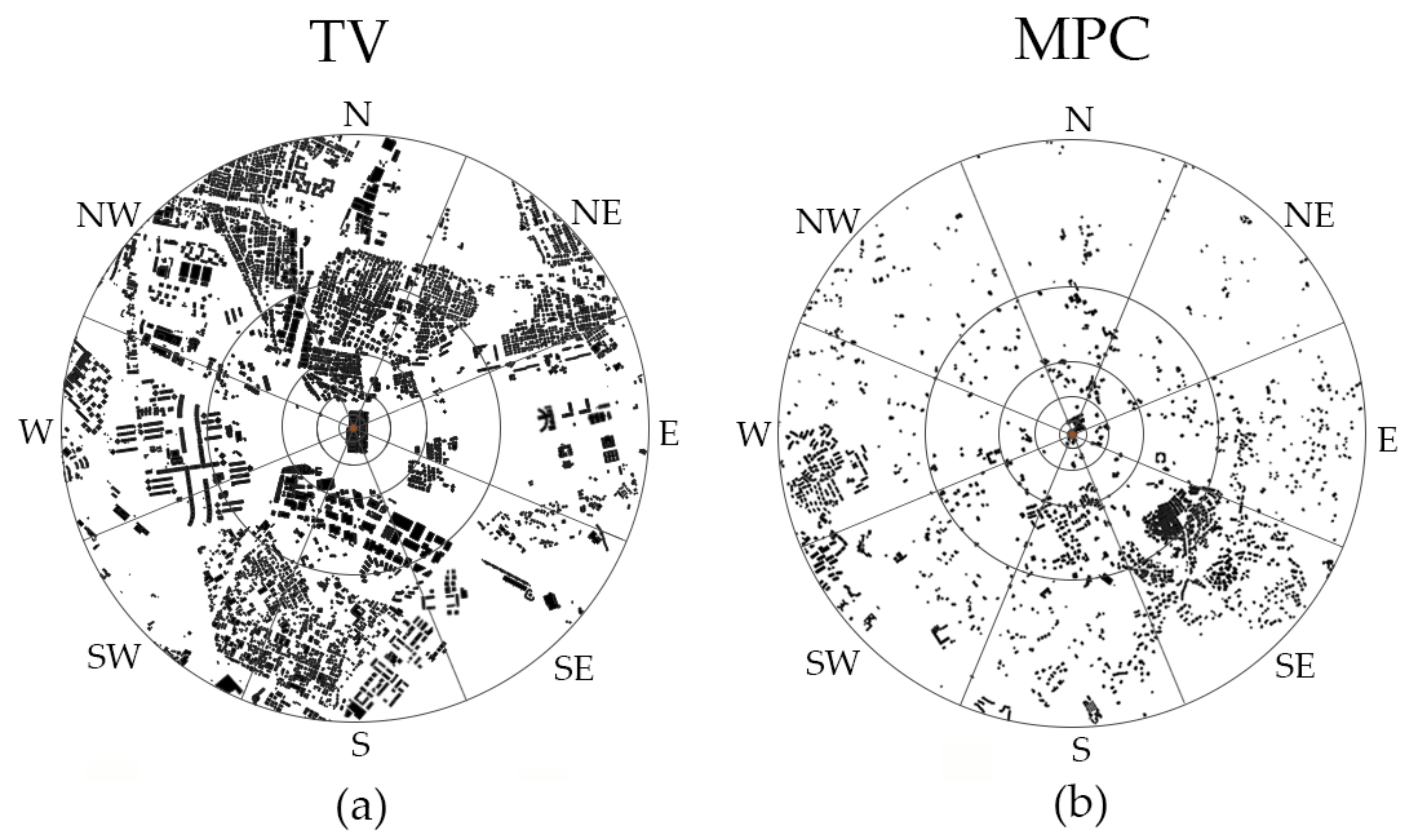
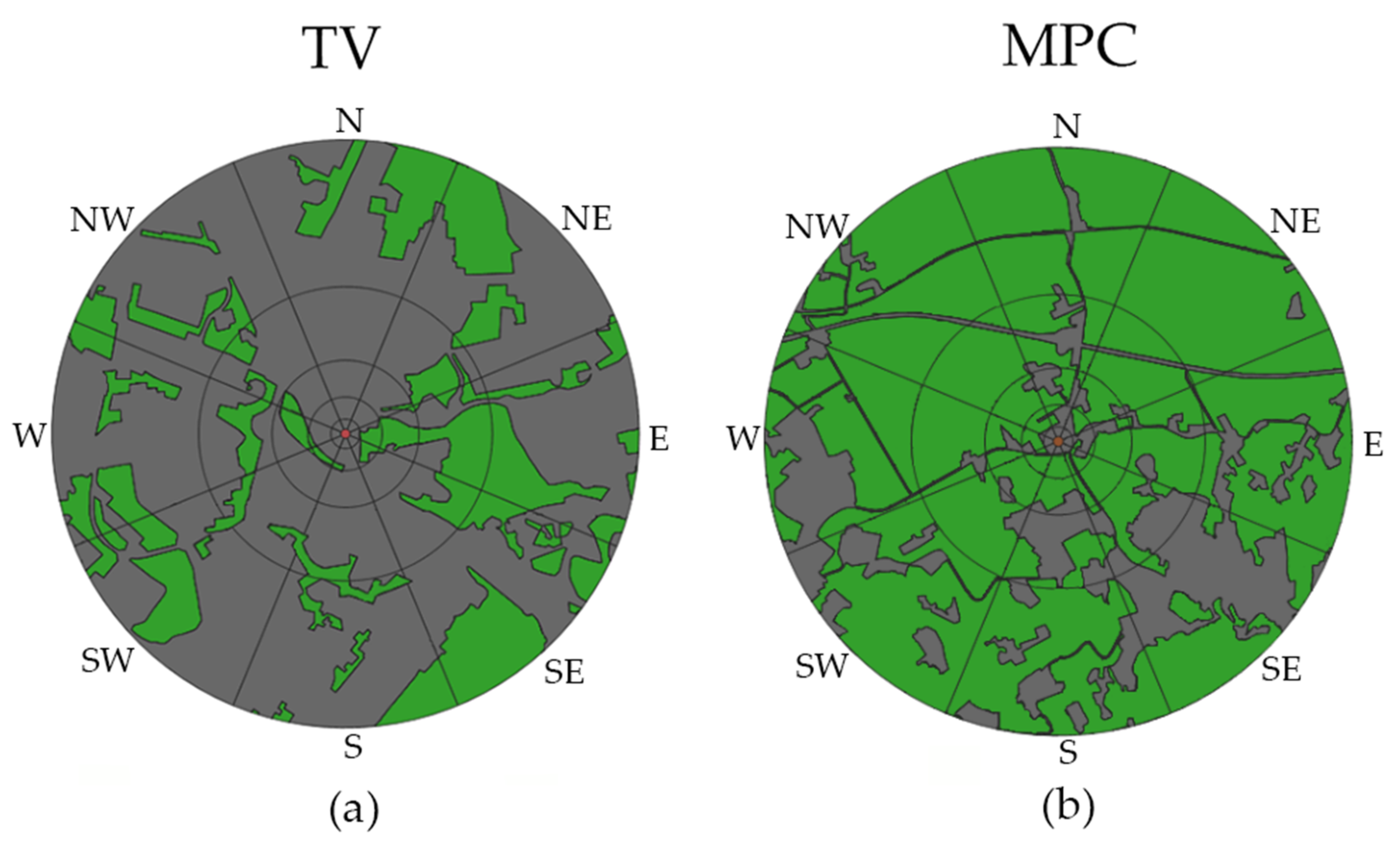
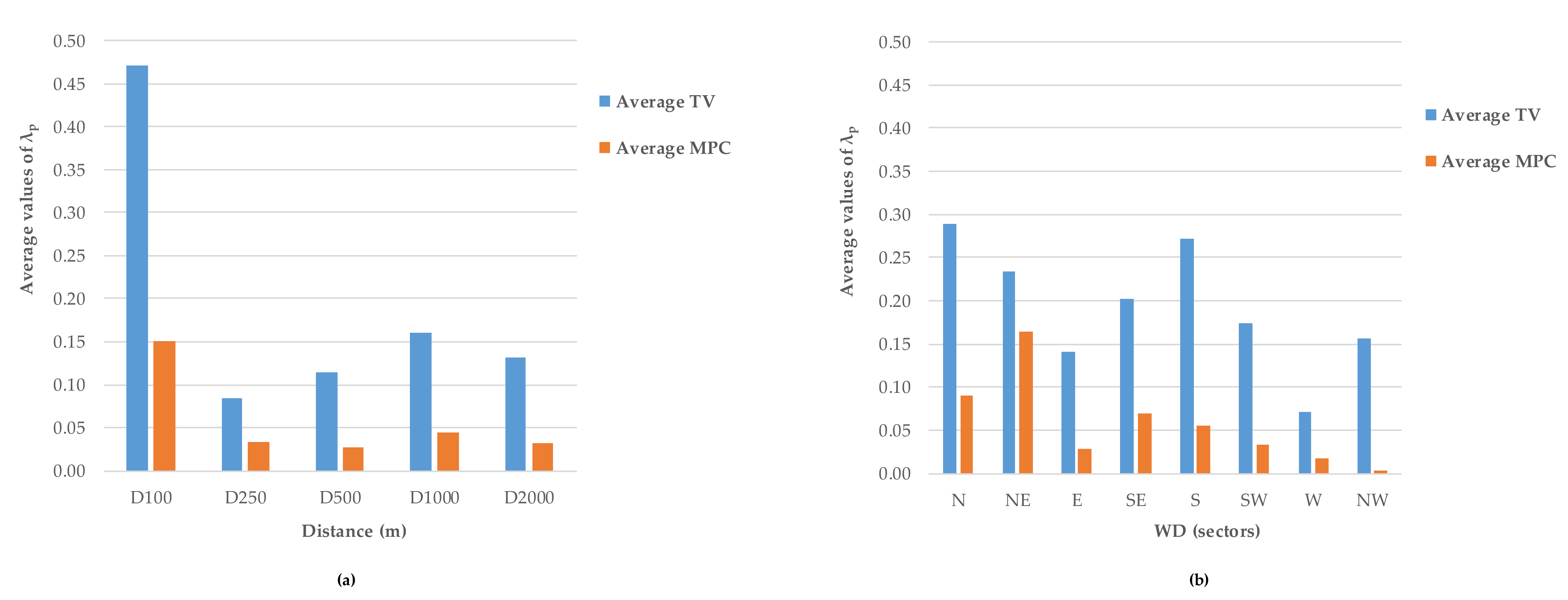
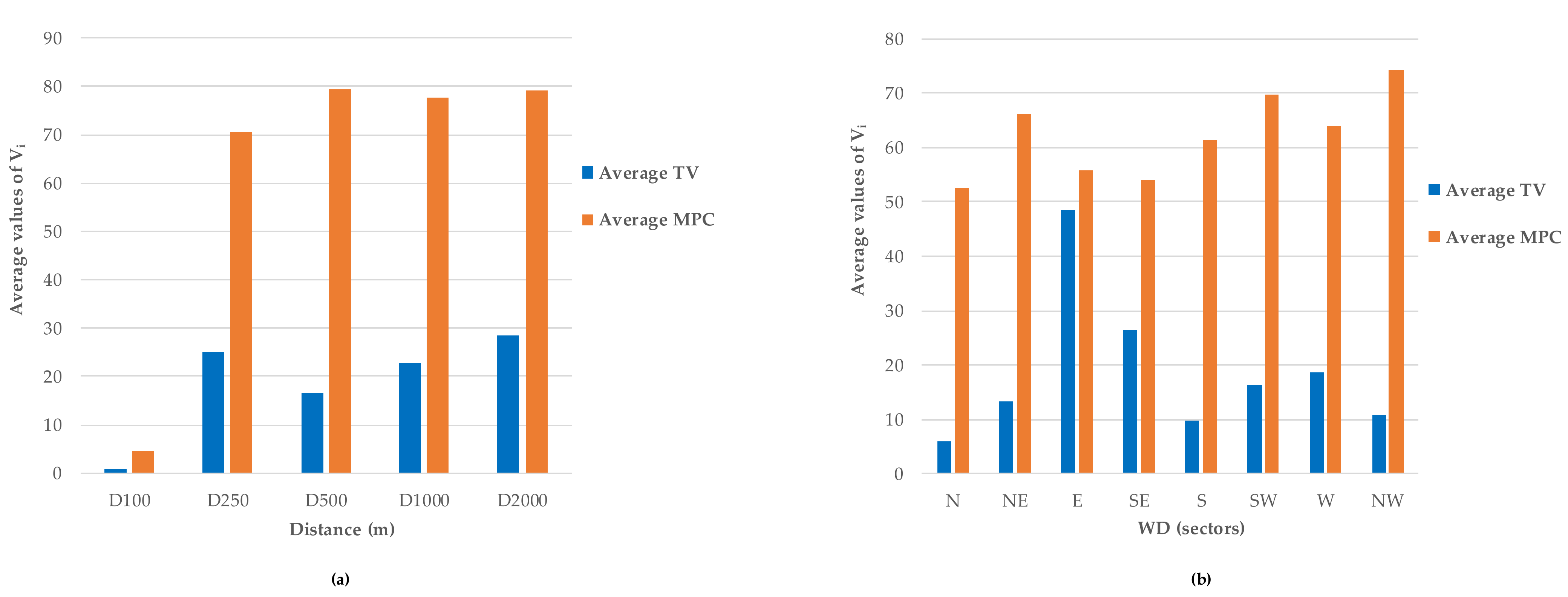
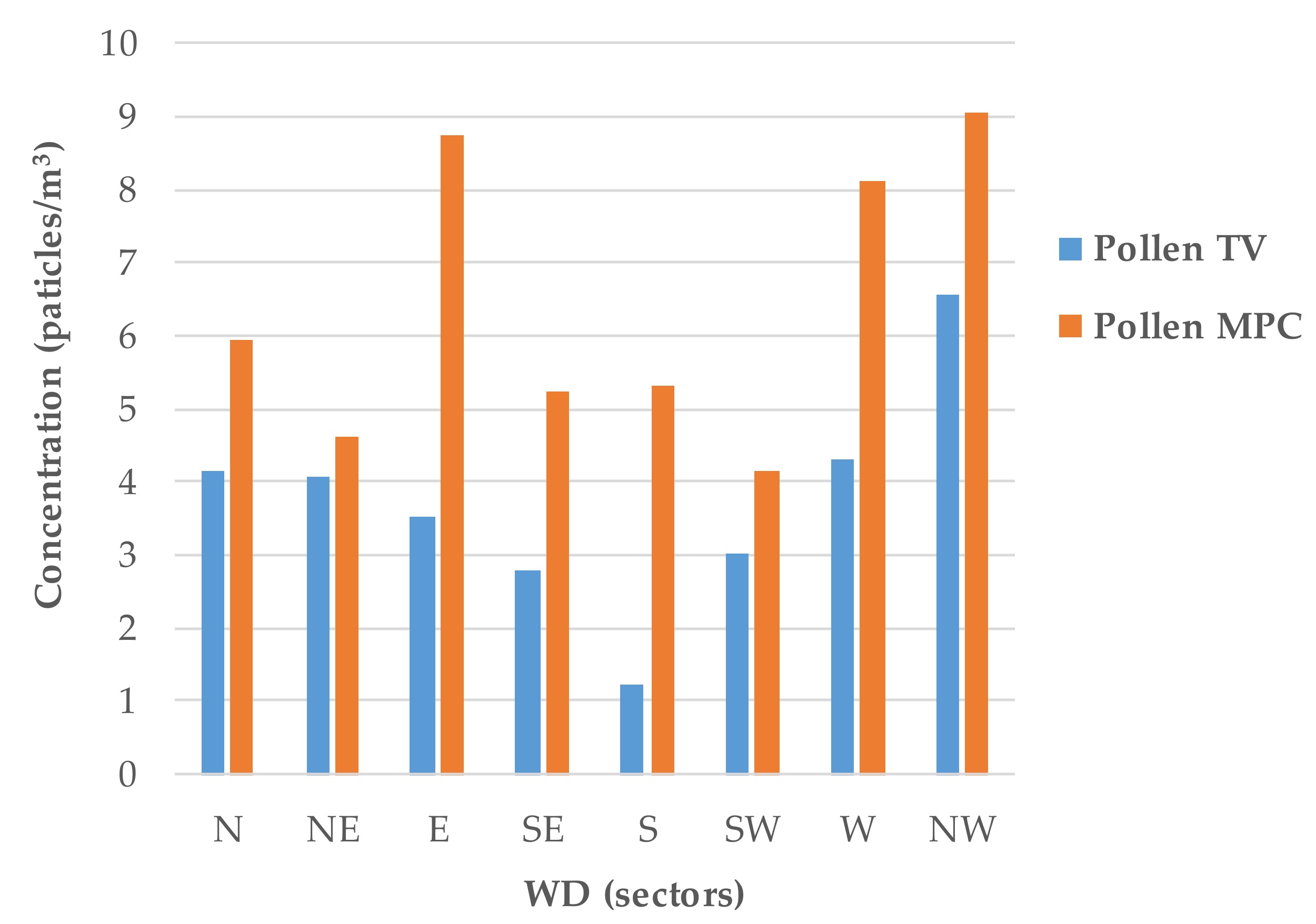
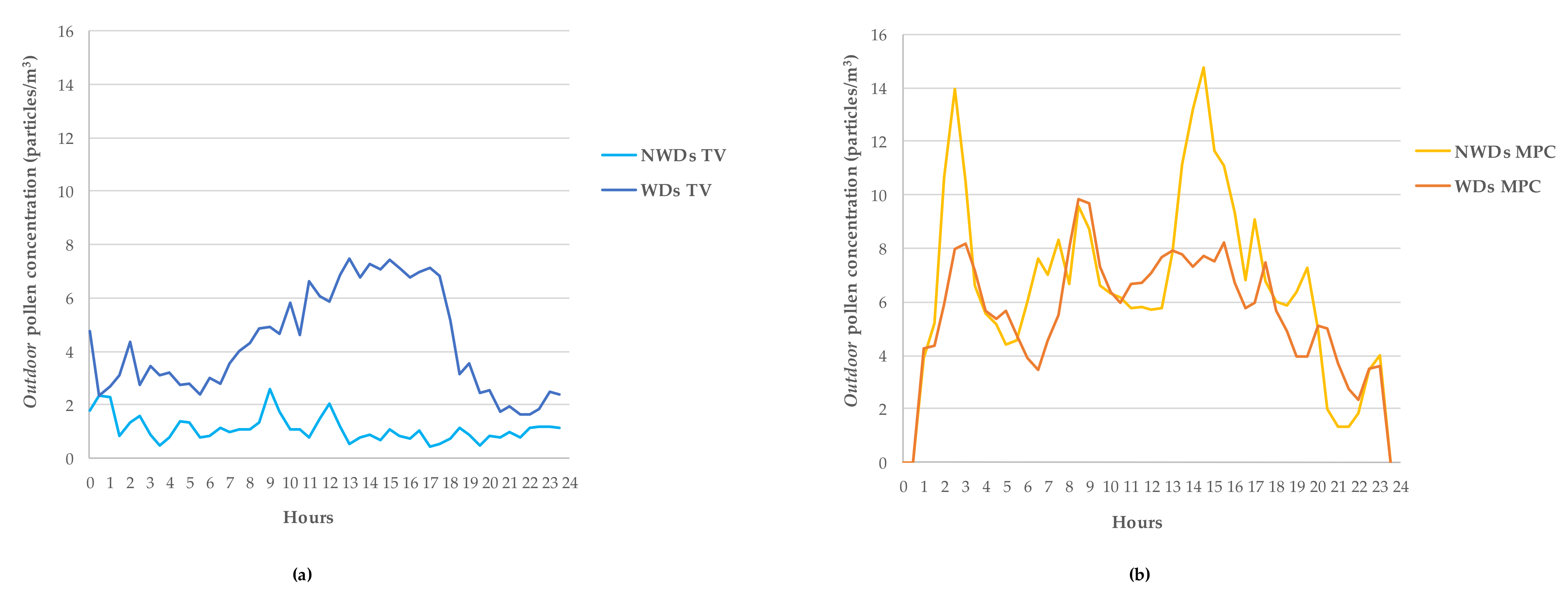
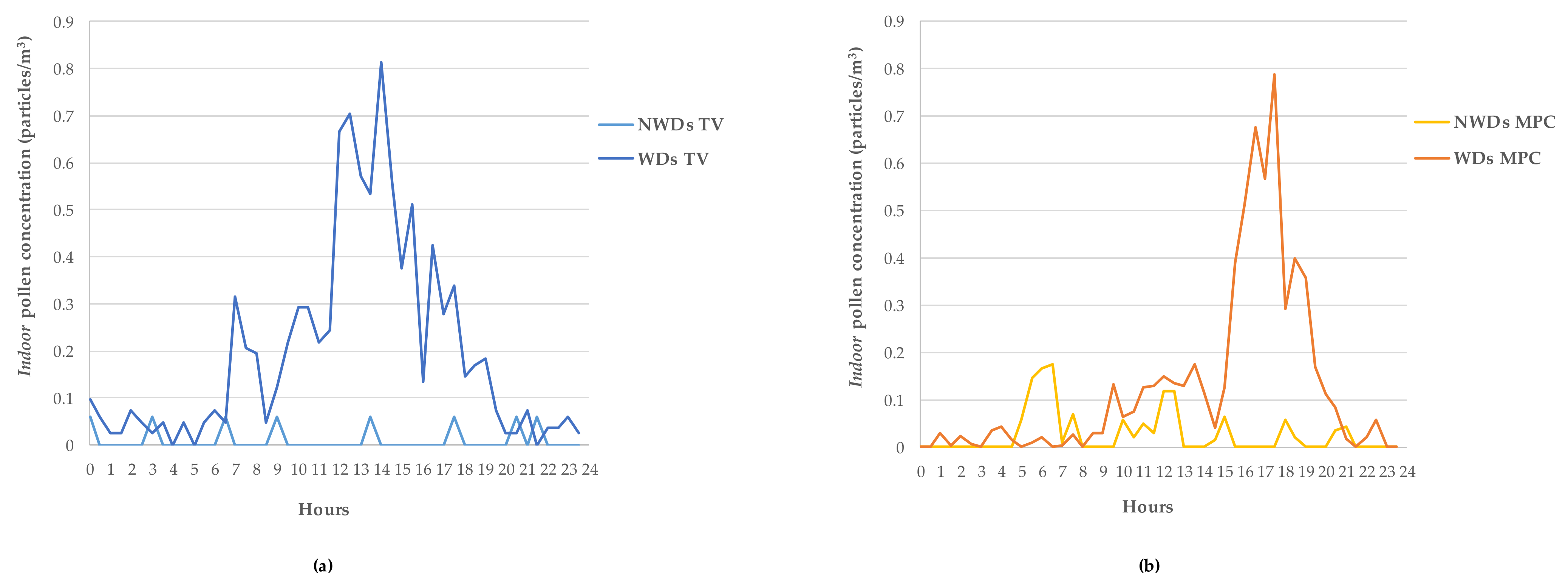
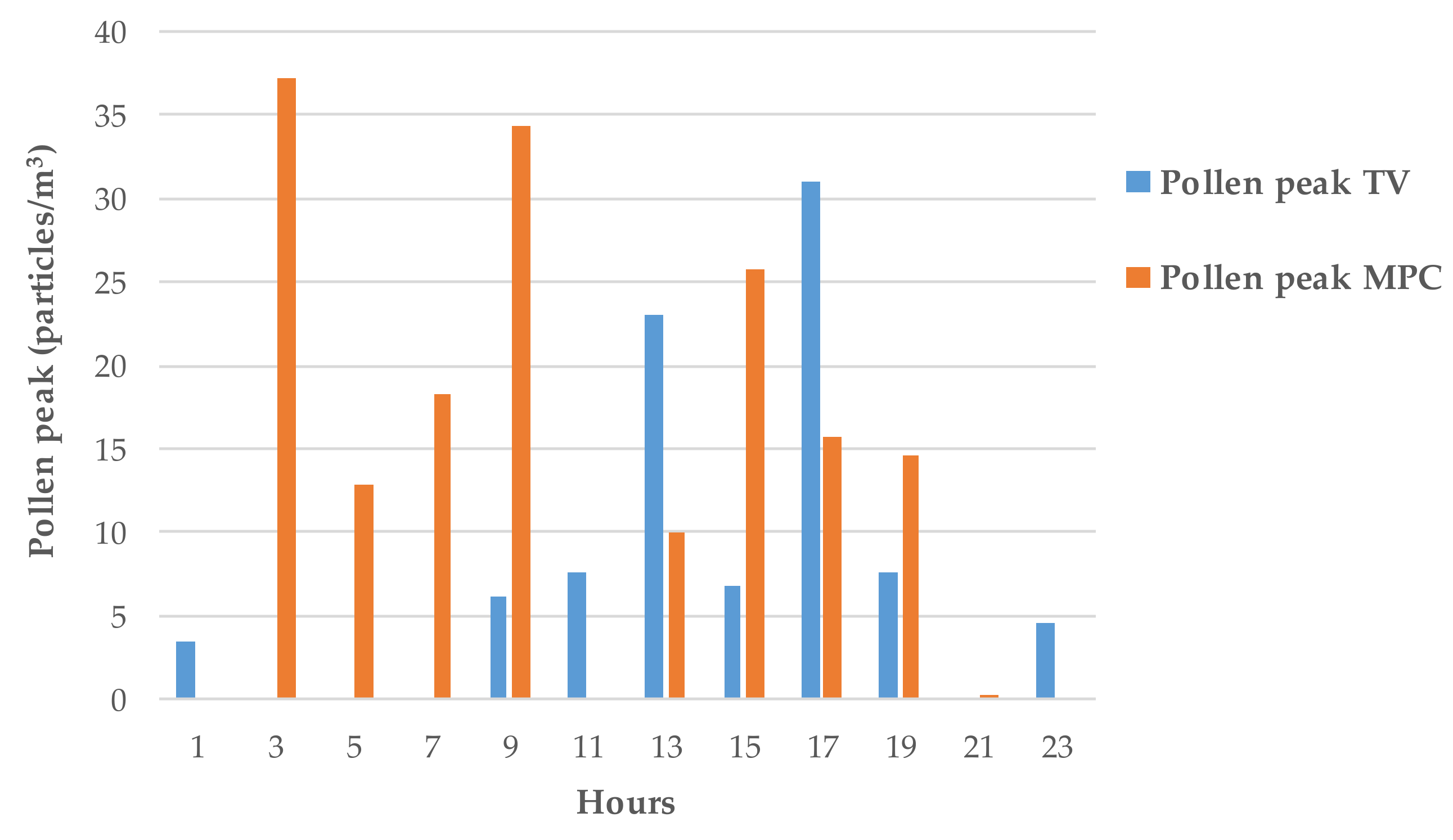
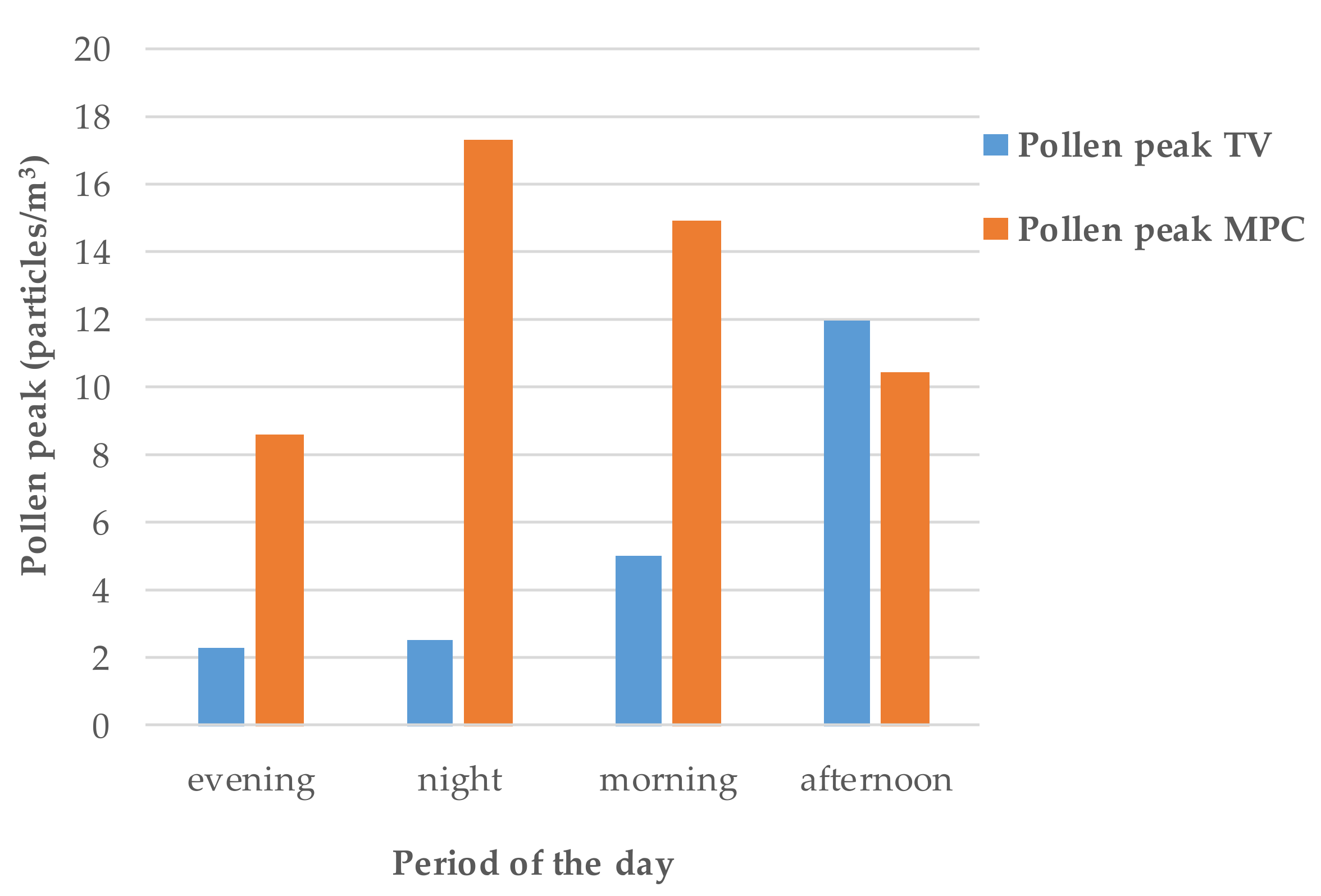
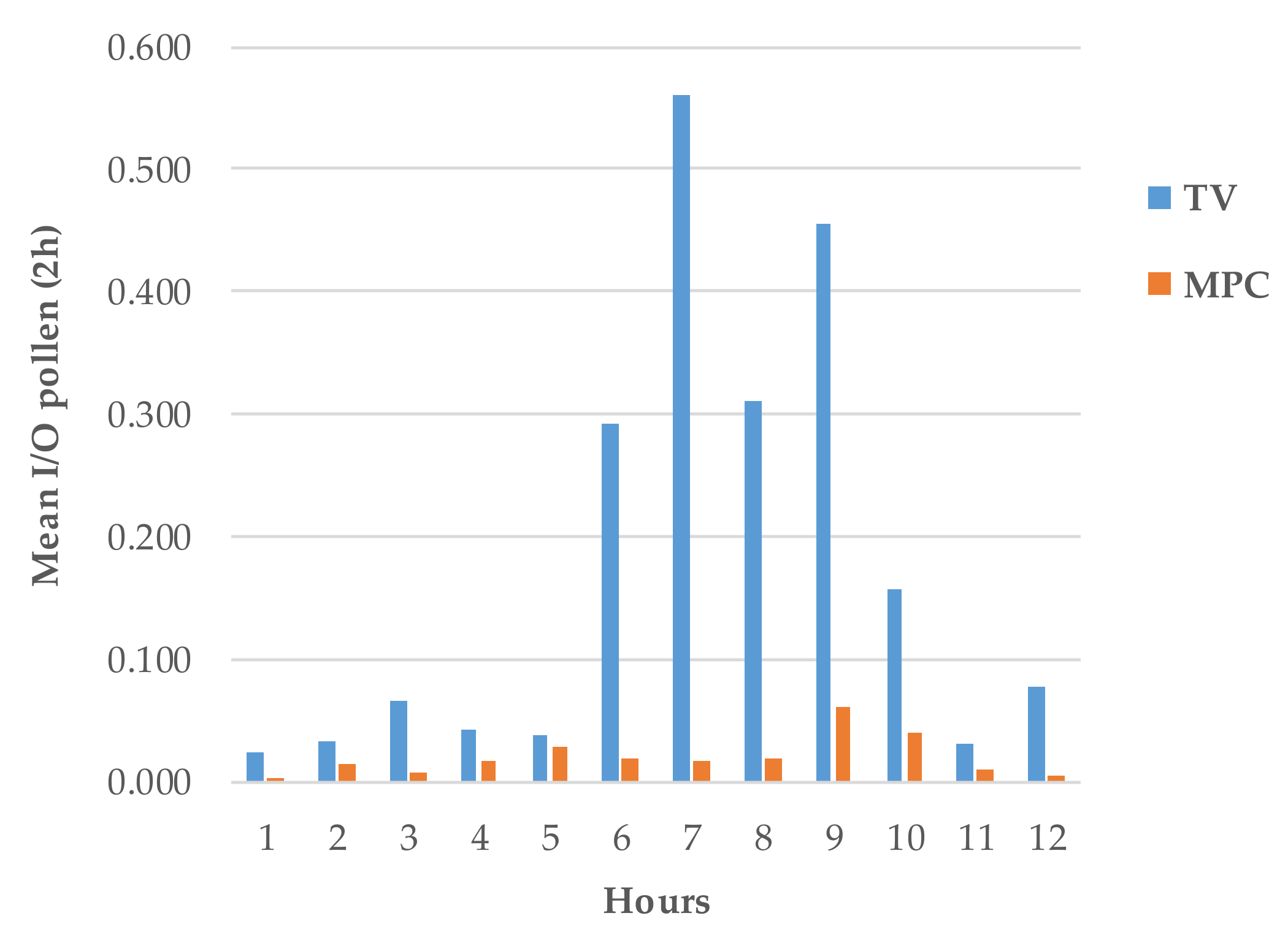

| TV | MPC | |||
|---|---|---|---|---|
| Indoor | Outdoor | Indoor | Outdoor | |
| Pollen (particles/m3) | 0.14 ± 0.53 | 3.19 ± 4.69 | 0.10 ± 0.49 | 5.91 ± 9.30 |
| Dmin (m) | Dmax (m) | |
|---|---|---|
| D100 | 0 | 100 |
| D250 | 100 | 250 |
| D500 | 250 | 500 |
| D1000 | 500 | 1000 |
| D2000 | 1000 | 2000 |
| TV (λp) | MPC (λp) | |||||||||
|---|---|---|---|---|---|---|---|---|---|---|
| D100 | D250 | D500 | D1000 | D2000 | D100 | D250 | D500 | D1000 | D2000 | |
| N | 0.60 | 0.17 | 0.26 | 0.26 | 0.16 | 0.31 | 0.05 | 0.05 | 0.03 | 0.01 |
| NE | 0.61 | 0.15 | 0.13 | 0.14 | 0.14 | 0.71 | 0.06 | 0.04 | 0.01 | 0 |
| E | 0.58 | 0 | 0.01 | 0.04 | 0.06 | 0 | 0.09 | 0 | 0.02 | 0.03 |
| SE | 0.65 | 0.13 | 0.02 | 0.15 | 0.05 | 0.05 | 0.03 | 0.02 | 0.16 | 0.09 |
| S | 0.64 | 0.18 | 0.12 | 0.24 | 0.14 | 0.08 | 0.03 | 0.06 | 0.08 | 0.03 |
| SW | 0.38 | 0.01 | 0.20 | 0.17 | 0.11 | 0.06 | 0.01 | 0.03 | 0.03 | 0.04 |
| W | 0.13 | 0 | 0 | 0.09 | 0.14 | 0 | 0 | 0.02 | 0.02 | 0.05 |
| NW | 0.18 | 0.03 | 0.18 | 0.19 | 0.20 | 0 | 0 | 0 | 0.01 | 0.01 |
| Average | 0.47 | 0.08 | 0.11 | 0.16 | 0.12 | 0.15 | 0.03 | 0.02 | 0.04 | 0.03 |
| TV (Vi) | MPC (Vi) | |||||||||
|---|---|---|---|---|---|---|---|---|---|---|
| D100 | D250 | D500 | D1000 | D2000 | D100 | D250 | D500 | D1000 | D2000 | |
| N | 0 | 0 | 0 | 0 | 30.55 | 0 | 40.47 | 55.02 | 72.07 | 95.52 |
| NE | 0 | 0.13 | 8.25 | 26.95 | 31.9 | 0 | 63.05 | 77.38 | 93.31 | 97.21 |
| E | 8.24 | 77.55 | 60.15 | 64.79 | 31.32 | 0 | 29.83 | 81.84 | 84.57 | 82.12 |
| SE | 0 | 56.32 | 1.77 | 28.24 | 46.52 | 8.42 | 76.19 | 94.53 | 45.93 | 45.33 |
| S | 0 | 15.32 | 0.22 | 14.05 | 19.95 | 28.7 | 100 | 59.38 | 42.29 | 76.87 |
| SW | 0 | 38.6 | 1.32 | 15.84 | 25.79 | 0.85 | 92.13 | 87.72 | 92.1 | 75.42 |
| W | 0 | 11.66 | 43.08 | 15.86 | 22.89 | 0 | 73.15 | 54.6 | 93.53 | 68.27 |
| NW | 0 | 0 | 17.84 | 16.41 | 19.32 | 0 | 89.29 | 93.66 | 96.63 | 91.42 |
| Average | 1.03 | 24.95 | 16.58 | 22.77 | 28.53 | 4.75 | 70.51 | 79.27 | 77.55 | 79.02 |
| N | NE | E | SE | S | SW | W | NW | |
|---|---|---|---|---|---|---|---|---|
| WD | 142.3 | 45.2 | 93.6 | 132.2 | 180.3 | 224.0 | 264.2 | 317.7 |
| WS | 1.5 | 1.1 | 1.9 | 1.2 | 1.4 | 0.8 | 0.7 | 0.8 |
| T | 10.8 | 9.5 | 7.8 | 7.6 | 10.9 | 10.4 | 11.9 | 11.9 |
| Rh | 68.3 | 78.4 | 83.5 | 87.1 | 84.3 | 84.7 | 67.8 | 61.3 |
| RS | 251.6 | 171.2 | 44.6 | 56.7 | 70.0 | 82.1 | 195.4 | 329.2 |
| Rain | 0 | 0 | 0 | 0.1 | 0.1 | 0.2 | 0 | 0 |
| Occupants | Opening Door | Opening Window | ||||
|---|---|---|---|---|---|---|
| TV | MPC | TV | MPC | TV | MPC | |
| 19:00–09:00 | 0.03 | 0.03 | 0.15 | 2.81 | 0.00 | 1.11 |
| 11:00–17:00 | 0.48 | 0.39 | 1.18 | 33.16 | 4.99 | 12.24 |
Publisher’s Note: MDPI stays neutral with regard to jurisdictional claims in published maps and institutional affiliations. |
© 2021 by the authors. Licensee MDPI, Basel, Switzerland. This article is an open access article distributed under the terms and conditions of the Creative Commons Attribution (CC BY) license (https://creativecommons.org/licenses/by/4.0/).
Share and Cite
Pelliccioni, A.; Ciardini, V.; Lancia, A.; Di Renzi, S.; Brighetti, M.A.; Travaglini, A.; Capone, P.; D’Ovidio, M.C. Intercomparison of Indoor and Outdoor Pollen Concentrations in Rural and Suburban Research Workplaces. Sustainability 2021, 13, 8776. https://doi.org/10.3390/su13168776
Pelliccioni A, Ciardini V, Lancia A, Di Renzi S, Brighetti MA, Travaglini A, Capone P, D’Ovidio MC. Intercomparison of Indoor and Outdoor Pollen Concentrations in Rural and Suburban Research Workplaces. Sustainability. 2021; 13(16):8776. https://doi.org/10.3390/su13168776
Chicago/Turabian StylePelliccioni, Armando, Virginia Ciardini, Andrea Lancia, Simona Di Renzi, Maria Antonia Brighetti, Alessandro Travaglini, Pasquale Capone, and Maria Concetta D’Ovidio. 2021. "Intercomparison of Indoor and Outdoor Pollen Concentrations in Rural and Suburban Research Workplaces" Sustainability 13, no. 16: 8776. https://doi.org/10.3390/su13168776
APA StylePelliccioni, A., Ciardini, V., Lancia, A., Di Renzi, S., Brighetti, M. A., Travaglini, A., Capone, P., & D’Ovidio, M. C. (2021). Intercomparison of Indoor and Outdoor Pollen Concentrations in Rural and Suburban Research Workplaces. Sustainability, 13(16), 8776. https://doi.org/10.3390/su13168776






